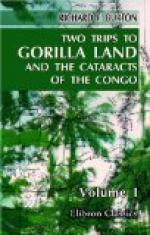Chapter IX.
A Specimen Day with the Fan Cannibals.
At 5 a.m. on the next day, after a night with the gnats and rats, I sallied forth in the thick “smokes,” and cast a nearer look upon my cannibal hosts. And first of the tribal name. The Mpongwe call their wild neighbours Mpangwe; the Europeans affect such corruptions as Fanwe, Panwe, the F and P being very similar, Phaouin and Paouen (Pawen). They call themselves Fan, meaning “man;” in the plural, Bafan. The n is highly nasalized: the missionaries proposed to express it by “nh” which, however, wrongly conveys the idea of aspiration; and “Fan,” pronounced after the English fashion, would be unintelligible to them.
The village contains some 400 souls, and throughout the country the maximum would be about 500 spears, or 4,000 of both sexes, whilst the minimum is a couple of dozen. It is pleasantly situated on the left bank of the Mbokwe River, a streamlet here some 50 feet broad, whose water rises 6 feet 10 inches under the tidal influence. The single street, about half a mile long, is formed by two parallel rows of huts, looking upon a cleared line of yellow clay, and provided with three larger sheds—the palaver houses. The Fan houses resemble those of the Mpongwe; in fact, the tribes, beginning at the Camarones River, build in much the same style, but all are by no means so neat and clean as those of the seaboard. A thatch, whose projecting eaves form deep shady verandahs, surmounts walls of split bamboo, supported by raised platforms of tamped earth, windows being absent and chimneys unknown; the ceiling is painted like coal tar by oily soot, and two opposite doors make the home a passage through which no one hesitates to pass. The walls are garnished with weapons and nets, both skilfully made, and the furniture consists of cooking utensils and water-pots, mats for bedding, logs of wood for seats and pillows, and lumps of timber or dwarf stools, neatly cut out of a single block. Their only night-light—that grand test of civilization—is the Mpongwe torch, a yard of hard, black gum, mixed with and tightly bound up in dried banana leaves. According to some it is acacia; others declare it to be the “blood” of the bombax, which is also used for caulking. They gather it in the forest, especially during the




